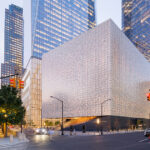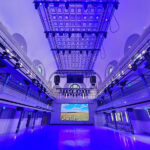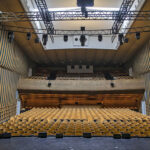San Diego’s U.S. Grant Hotel’s $52M Renovation left the architects asking for more.
It’s an unusually cold, nasty winter night in San Diego, and Tony Hansen is 11 stories up on the roof of the historic U.S. Grant hotel. He’s with the architects spearheading a $52 million renovation, and he is showing them some possible solutions to lighting the exterior of the building. All he has to do is flip the right switch on his computer to turn on the LEDs hung on the outside of the building to produce the right color of amber as specified. His fingers slip, and the lights come up a different color.
The architect tells him that’s not necessary — they just need amber.
“I let my fingers slip again, and a red and green Christmas look came up,” Hansen says. That stops the architect cold, and he ambles over to Hansen, sighs, and says, “All right. Show me what this can do.”
“This was an awakening,” Hansen says. “Most architects aren’t prepared to expect the possibilities of LED. Once they knew it could do other colors, they asked how much more the extra colors would cost — they were prepared to pay extra. I had to have a meeting over dinner to explain that as long as they were using LEDs on the building, the colors were already going to be there.
“It’s a clash of industry cultures. Most architects haven’t a clue of what LEDs can do.”
Located in the historical Gaslamp Quarter of downtown San Diego, the Grant has been granting luxury accommodations to the well-to-do — including 13 U.S. presidents — since 1910. The hotel has had multiple renovations since opening, including a partial one as recently as 2004. But this renovation was larger than most, and particularly strove to retain its elegance from a bygone era while modernizing it. The contradiction was especially hard to resolve when it came to lighting up the outside of the building.
“The Grant is amazing,” says Hansen, a lighting designer/systems consultant for Orlando- based Techni-Lux. “They found hidden rooms, a tunnel that used to go to a speakeasy, an old swimming pool in the basement — things that no one knew were there.” And it was haunted. But more on that later…
Language Barrier
The lighting designer on the project was Chris Maresca of S.K.I.N., an architectural design firm that specializes in designing products that light up buildings. “Our studio had been experimenting with LED in product design, and when we realized its long life span and low energy usage, that was a main incentive to use it for the Grant.”
S.K.I.N. contacted Hansen to get involved in October of 2005. At first there was some confusion between the two artisans; it seems they have much in common, but their vocations are actually quite different.
“It was scary because we both had each other’s terms confused,” Hansen says. “I ended up flying out there to discuss things in person. Then we started crawling around this old decrepit and haunted building together.” The original goal was to replace the sodium-vapor fixtures and maintain the same yellow look the hotel has always had. Soon all involved were leaning toward LEDs, including the renovation architects, but Hansen stresses it was because of ease of maintenance and lower power consumption. “The drive for LED from the beginning was not because of the color possibilities. In fact, I was under strict orders to just give the building a yellow look.”
Hansen did a lot of spreading the Gospel According to LED when he was working on the project. It astounded the architects that the LEDs could project seven stories high with room to spare at totally acceptable illumination levels. There was the minor additional cost of the DMX control needed to access the colors, and the overall cost for the outside lighting feature came in at just under a million dollars. Installation began in July of 2006, and it was completed and turned on just in time for Christmas — when the color scheme of red and green announced that the Grant had arrived.
Eighty-one SGM Palco 3 and 53 Pulsar ChromaBatten fixtures were used. Their ability to project at narrow angles and throw long distances allowed them to provide a more sculpted feel. A ShowCAD Artist PC-based system is used to control it through a Pathway Connectivity Pathport Ethernetto- DMX interfaces.
“There’s nothing else like the SGM Palco 3 on the market,” says Hansen. “The fact that I’m comfortable lighting five to seven stories and still have overhead left over is a testament to my faith in the product. The ShowCAD offers a wonderful ease of use with LED and time clock function.”
Learning Curves
Hansen laughs when he is asked about challenges, then stutters a bit. Where to begin?
“Try to wire a historical building where you’re not allowed to do a lot of penetration. That was amazing and luckily something the electrician had to mostly deal with. A lot of careful conduit lighting followed by painting to match the building happened — and there’s a lot of lights on the building.” San Diego-based Neal Electric handled the install, and “there was a heck of a learning curve in them figuring out how to deal with DMX and the intricacies that we in this industry take for granted.”
Making sure that the fixtures fit cosmetically in a building as big and historic as this one required some delicate handiwork as well.
“The fixtures are pretty large, so one of the concerns was that they weren’t going to obstruct the façade,” says Maresca. “The nice thing about LED is the low profile compared to the sodium-vapor fixtures. LED is streamlined housing, and the fixture has kind of a high-tech look that adds a modern element. But it works because it’s slim and really cuts into the horizontal lines of the building.”
As for those financing the Grant’s renovation and City Center Development Corporation (CCDC) who oversaw it all, they are excited about the possibilities — cautiously.
“It’s not something they utilize to the fullest extent,” says Maresca. “They could have any array of color schemes out there, but since it’s a historic building we had restrictions on what colors we could use. When we were first doing the installation, the CCDC had issues because they didn’t want it to be some casino-looking thing. They wanted amber to give the building an antique feeling. Now, though, they can use [the color options] as a promotional tool, light the building in corporate colors, and collect additional fees for it.”
As for Hansen, he had some fun. To test the system, he stood across the street from the Grant in front of the hotel on his cell phone to his wife, Lisa, who was in the Grant’s control room. He was testing the system by asking her to change the colors on the building.
So if the architects were unfamiliar with the possibilities of LED on the outside of a building, imagine how it hit the locals walking by …
“It became a game,” smiles Hansen. “I was calling different colors, and Lisa was bringing them up. Then a guy in a brown jacket walks by and sputters, ‘green,’ and I repeat it into the cell phone, and suddenly the entire building is green. Others, on the fly, were shouting out different colors to me, and I was repeating them, and it was on the fly. I don’t know if they even made the connection and figured out what I was doing, but they sure were astounded by it!”
But ultimately, the bridging of the two worlds in this situation was overcome. The idea was to provide lighting in a difficult location. The tool was entertainment lighting, not for entertainment’s sake, but for pragmatic reasons… But hell, while it was there, why not have some fun with it?
While at first the historical society and the owners of the hotel, Westin, laid down very strict rules regarding what could be done with the LEDs — no disco, no rainbows, no lots of things — those rules turned out to be more along the lines of guidelines. For example, when the local baseball team, the San Diego Padres, were having an especially exciting run up to the playoffs, the hotel was lit up in the team’s colors, navy blue and tan.
“It’s become a selling point to the building,” Hansen says. At the end of the day, the take home for Hansen is that a connection desperately needs to be built between the worlds. “It’s been an amazing learning curve for me in terms of learning how to explain the possibilities, and a curve to the architects to get their minds around it.”
Oh, and the ghost…
Lots of people saw/heard/felt things as the crew made discoveries into hidden rooms and a silenced past, but there’s also some proof — there’s tape from a security camera that panned a room, and despite no real person being in it, when it panned back items in its view were mysteriously and unexplainably moved.
Calls to the ghosts to comment on the LEDs went unreturned.


